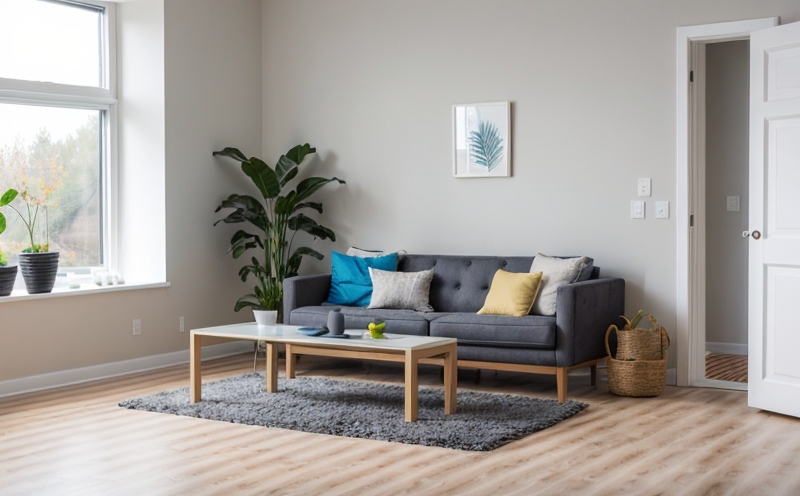ISO 16000-7 Determination of Formaldehyde in Air
The determination of formaldehyde in air is a critical component of indoor air quality testing. Formaldehyde, a colorless gas with a pungent smell, can be released from various sources such as building materials, furniture, and certain cleaning products. According to the International Organization for Standardization (ISO), ISO 16000-7 provides a standardized method for measuring formaldehyde in air using passive samplers.
The ISO 16000 series of standards is designed to ensure that indoor environmental quality testing methods are consistent and reliable across different regions. This standard specifically addresses the measurement of volatile organic compounds, including formaldehyde, which can have significant health implications if present at high levels in indoor environments. Formaldehyde exposure has been linked to various adverse health effects such as irritation of the eyes, nose, and throat; headaches; and difficulty breathing.
The testing process begins with the selection of appropriate passive samplers that are placed in the air for a specified period. These samplers absorb formaldehyde from the ambient air, allowing for accurate measurement upon retrieval. The key step involves desorption of the absorbed formaldehyde using water or another suitable solvent and subsequent analysis using gas chromatography (GC) or other analytical techniques recognized by ISO standards.
The accuracy and precision of this method are critical to ensure that the results reflect actual concentrations in the air. Proper calibration, standardization, and quality control measures must be strictly adhered to during each step of the process. Compliance with ISO 16000-7 ensures that the testing methodology is consistent with internationally recognized standards, thereby enhancing confidence in the results.
In summary, ISO 16000-7 provides a robust framework for determining formaldehyde levels in air, which is essential for maintaining good indoor air quality and ensuring occupant health. This standard plays a vital role in environmental monitoring, particularly in buildings where people spend significant time indoors. By adhering to this protocol, laboratories can provide reliable data that informs decision-making processes related to ventilation systems, material selection, and overall building design.
Why Choose This Test
The ISO 16000-7 method is widely recognized for its accuracy and reliability in measuring formaldehyde levels in air.
This standard ensures consistency across different testing environments, making it suitable for both research and regulatory compliance.
Testing with this protocol allows for the identification of potential sources of formaldehyde, enabling targeted interventions to improve indoor air quality.
The test is particularly beneficial for organizations involved in HVAC equipment design, where maintaining optimal indoor air quality is paramount. By choosing ISO 16000-7, stakeholders can ensure that their testing practices meet the highest international standards and contribute to a healthier indoor environment.
Quality and Reliability Assurance
The process of determining formaldehyde in air using ISO 16000-7 involves several quality control measures to ensure reliability. Calibration of samplers is critical, ensuring that the devices accurately reflect the concentration of formaldehyde present. Regular calibration against known standards guarantees consistent results over time.
Standardization plays a crucial role in this testing method by providing clear guidelines on how to conduct the test. These include specifications for sample collection periods, storage conditions, and analytical techniques. By adhering strictly to these parameters, laboratories can minimize variability and ensure reproducibility of results.
Quality assurance extends beyond mere procedural adherence; it also encompasses continuous improvement efforts aimed at enhancing testing methods. This includes staying updated with advancements in technology and methodologies that could improve accuracy or efficiency.
In conclusion, the combination of rigorous calibration, standardized procedures, and ongoing quality improvements ensures that ISO 16000-7 remains a reliable tool for measuring formaldehyde levels in air. This commitment to excellence not only enhances trustworthiness but also supports effective decision-making regarding indoor air quality management.
Environmental and Sustainability Contributions
Measuring formaldehyde in air contributes significantly to environmental sustainability efforts by providing insights into potential sources of pollution within enclosed spaces. By identifying these sources early on, corrective actions can be implemented promptly, reducing the overall impact on human health and ecosystems.
The reduction of formaldehyde emissions from indoor environments helps create healthier living conditions for occupants while minimizing adverse effects on both people and natural resources outside buildings. This aligns with broader goals associated with sustainable development initiatives aimed at improving quality of life globally.
Moreover, by adopting ISO 16000-7 as part of routine monitoring practices, organizations contribute positively towards fostering healthier indoor environments. Such actions reflect a proactive approach to environmental stewardship and demonstrate commitment to long-term sustainability objectives.





